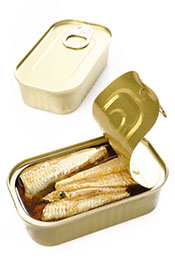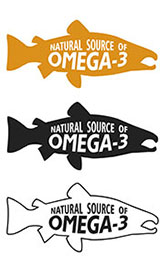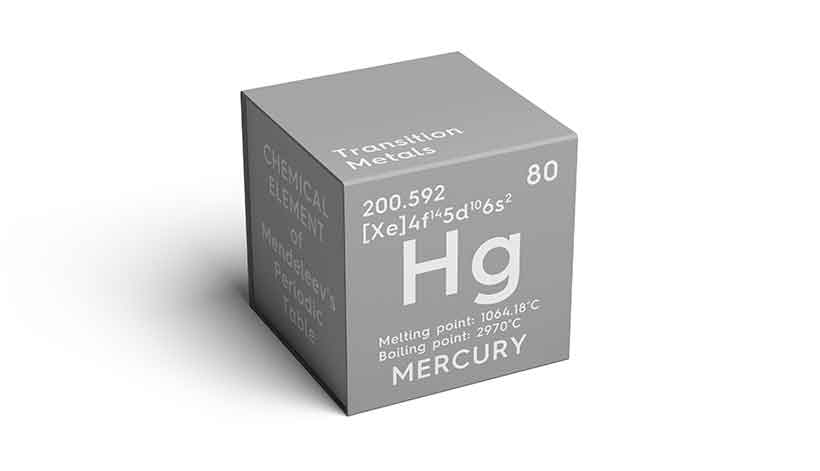Sardines may not enjoy the popularity that other types of seafood do, but they’re one of the most nutrient-dense foods on the planet.
This article takes a look at their nutrition profile, eight of their health benefits, and some tasty recipes.
We’ll also examine the differences between fresh and canned sardines, and whether the type you choose matters.
What Are Sardines?
Sardines are a small, nutrient-rich fish that belong to the herring family.
Similar to other members of the herring family, sardines are an oily-fish that provide a wealth of omega-3 fatty acids.
Unlike salmon, cod, mackerel and other fish, people eat sardines whole including the bones, flesh and organs.
They are available either fresh or in canned form, in which they are usually packed in oil or tomato sauce.
It is likely that the name ‘sardine’ originates from the island of Sardinia, Italy, with historical records of the fish being caught there as early as the 15th century (1).
Nutrition Profile
Sardines are one of the most nutritious fish on the planet.
The tables below show the nutritional value of sardines per 100 g, including both macronutrient and micronutrient profiles (2).
Macronutrients and Vitamins
| Nutrient | Amount (Grams / % RDA) |
| Calories | 208 kcal |
| Carbohydrate | 0 g |
| Fat | 11.5 g |
| Protein | 24.6 g |
| Vitamin B12 | 149 % |
| Vitamin D | 68% |
| Vitamin B3 | 26% |
| Vitamin B2 | 13% |
| Vitamin E | 10% |
| Vitamin B6 | 8% |
| Vitamin B5 | 6% |
| Vitamin B1 | 5% |
| Folate | 3% |
| Vitamin K | 3% |
| Vitamin A | 2% |
| Vitamin C | 0% |
Minerals
| Nutrient | Amount (Grams / % RDA) |
| Selenium | 75% |
| Phosphorus | 49% |
| Calcium | 38% |
| Sodium | 21% |
| Iron | 16% |
| Potassium | 11% |
| Magnesium | 10% |
| Copper | 9% |
| Zinc | 9% |
| Manganese | 5% |
As these nutrition facts show, sardines are rich in protein, healthy fat, and virtually every essential vitamin and mineral.
Among these, they are particularly high in vitamins B12, B3, D, selenium, phosphorus, and iron.
Health Benefits of Sardines
Eating sardines can benefit our health in so many ways, from their high calcium content to their provision of omega-3.
Here is a look at nine great advantages sardines bring to our diet;
1. Rich Source of Bio-available Calcium
Calcium is an essential mineral that is important for skeletal and dental health.
Depending on the dietary system, some people may be more prone to a deficiency in this mineral. For instance, vegan dieters and people who follow strict paleo (no dairy) diets.
For the latter group at least, sardines are a great option.
We eat sardines whole, including all the tiny bones that they contain. As a result, sardines provide a substantial amount of calcium; per 100 grams, they contain approximately 38% of calcium’s RDA (2).
Furthermore, not all food sources of calcium are equal.
For example, many plant-based sources of calcium (e.g. spinach) contain a compound called oxalic acid (oxalate).
Unfortunately, oxalates bind calcium in the body, so the higher proportion of oxalate food has, the lower the calcium absorption (3).
However, since sardines contain no oxalic acid at all, they are one of the highest bio-available sources of calcium.
2. High in Omega-3 Fatty Acids
One of the best health benefits of sardines comes from their omega-3 content.
Sardines provide a substantial amount of the omega-3 fatty acids EPA (eicosapentaenoic acid) and DHA (docosahexaenoic acid).
Per 100 gram portion, sardines provide 1480 mg of omega-3 per 100 grams, which is a significant amount (2).
Why Is Omega-3 Important?
Omega-3 fatty acids have anti-inflammatory actions within the body, and research demonstrates that they help prevent a variety of chronic diseases (4, 5, 6).
However, omega-6 fatty acids have an essential pro-inflammatory effect. Our body requires these inflammatory processes from time to time, but the modern diet has skewed the delicate balance between omega-3 and 6.
In evolutionary terms, something along the lines of a 1:1 ratio between omega-6 and omega-3 was the norm. On the contrary, the modern Western diet often exceeds 15:1 in favor of omega-6 (7).
Although inflammation is important, too much is bad, and chronic systemic inflammation has links to everything from dementia to cancer and cardiovascular disease (8, 9).
Consuming oily fish like sardines helps to increase our body’s omega-3 stores, but we should ideally avoid omega-6 vegetable oils too.
For further options, see here for a guide to more omega-3 rich fish.
3. Excellent Source of Vitamin D
The single best source of vitamin D is sunlight, but not everyone is fortunate enough to have sufficient exposure.
Particularly for those who live in the Northern hemisphere, alternate sources of vitamin D are important during the long, dark winters.
Among food sources of vitamin D, sardines are one of the best, and a 100-gram portion provides 68% of the RDA (2).
Importance of the Sunshine Vitamin
Vitamin D is a hormone rather than a true vitamin, and it is critical for our health.
The ‘sunshine vitamin’ plays a vital role in immunity and the skeletal system. This fact makes it critical as we age, as it can help to prevent conditions like osteoporosis and cognitive decline (10).
In fact, vitamin D is associated with a reduced risk of almost every chronic disease. Therefore, it makes sense that deficiency leads to an increase in all-cause mortality (11).
Unfortunately, much of the world is deficient in the vitamin. Approximately 1 billion people have inadequate blood levels of vitamin D, likely a result of our modern indoor lifestyle and excessive sunscreen use (12).
4. Sardines Are Rich in Protein
There are many reasons why getting sufficient dietary protein is important.
First of all, protein is essential for the synthesis of hormones and the growth and repair of cells and muscles (13).
Furthermore, diets with sufficiently high protein intake are associated with better body composition and greater satiety (14).
On this note, having more lean mass and a greater feeling of satiation can positively influence our diet and overall health.
If we are looking to increase our protein intake, then sardines are an excellent way to do so.
Per 100 grams they provide around 25 grams of protein (2).
Depending on how much protein you require, they could also be a great high-protein snack between meals.
5. Sardines Contain Large Amounts of Selenium
Selenium is a mineral that plays a role in many critical biological processes.
Among these, the mineral has an antioxidant role in the body and helps to attenuate oxidative stress. Selenium also plays an essential role in DNA repair and the proper functioning of the endocrine and immune systems (15).
Also, adequate selenium intake is necessary to maintain optimal thyroid health. The thyroid gland contains the most concentrated amounts of selenium in the body, and a deficiency can lead to autoimmune conditions (16).
Our intake of selenium can vary greatly depending on the composition of the local soil.
If the soil is depleted in selenium, then the food grown from it will contain inadequate amounts too. Worldwide, approximately 1 billion people are believed to have insufficient intakes of selenium (17).
Fortunately, many foods still offer high concentrations of this important mineral. In this context, sardines are one of the very best, and they provide a substantial 75% of the RDA for selenium per 100 grams (2).
6. Sardines Are Very Low in Mercury
Thus far, we have only looked at the benefits of sardines.
However, most people know that seafood has a pretty substantial downside; methylmercury contamination.
Some oily fish, such as bigeye tuna, contain large enough concentrations of mercury for the FDA to advise completely avoiding them (18).
So, how do sardines fit in?
Fortunately, as a very small fish, sardines are near the bottom of the food chain, and so they only consume tiny amounts of mercury.
Notably, sardines are among the five seafood choices with the very lowest amount of mercury contamination. The mean mercury concentration that this fish provides is only 0.013 PPM (19).
Rest assured, you can enjoy the health benefits of sardines without having to worry about their mercury content.
7. Impressive Nutrient-Density
As we have seen throughout this article, sardines are incredibly nutrient-dense, and they supply the majority of essential nutrients.
However, when we take a total view of everything these fish provide, it is even more impressive;
- An alternative source of selenium to brazil nuts.
- The same omega-3 fatty acids as mackerel and salmon.
- A protein content almost equivalent to chicken breast.
- More than two-thirds of the RDA for vitamin D.
When you add all these benefits together, it is very impressive considering that a single can of sardines contains less than 200 calories.
This just shows how nutritious sardines are; they are one of the healthiest food choices to include in your diet.
8. Sardines Are Cheap
Another great benefit of sardines is their affordable price.
I know everyone loves salmon, but it can be costly depending on where you live.
On the other hand, everyone has access to either fresh or canned sardines, and the cost is quite economical.
You can buy wild sardines for little over $2 per can.
On a gram per gram basis, this is much cheaper than most other species of wild fish. For instance, you will have a difficult time finding wild salmon for an equivalent price.
Although the price isn’t a health benefit as such, it does mean that a wider variety of people can benefit from these oily fish.
Fresh vs. Canned Sardines
Many people wonder whether canned sardines are just as healthy as the fresh variety.
Before I looked into it, this is something I often thought about too, so let’s have a quick rundown of the considerations.
Availability
You can source canned sardines virtually everywhere you go in the world, but it is not always possible to find fresh ones.
Raw vs. Cooked
Fresh sardines are found in their raw state, and you can control how you cook them at home.
On the other hand, canned sardines are usually steam cooked in their cans – the temperature will vary depending on brand/company.
Some people have concerns that this heat treatment may cause the fatty acids in the fish to oxidize. Unfortunately, there is not a tremendous amount of research available on sardines and oxidation.
However, one study showed that the omega-3 content of the sardines decreased slightly following heating and canning. Despite this, the fish remained a good source of omega-3 (21).
There is little substantial data on the generation of oxidized products, so I wouldn’t worry too much.
Nutrients
The nutritional content of fresh and canned sardines is the same; it is only the freshness that is in question.
Fresh foods are usually preferable to processed ones, and this is the case here too. Overall, fresh sardines are the better choice if they are available.
However, canned sardines are just as good for you nutritionally, and either choice is better than no sardines!
5 Tasty Ways To Eat Sardines
Some people dislike the taste of ‘plain’ sardines, so here are a few quick and simple ways to eat them.
Each idea requires minimal preparation and very few ingredients.
- Marinate the sardines in olive oil, lemon juice, and parsley for a few hours before eating.
- Add sardines to a Mozzarella and tomato leafy green salad.
- Flavor the sardines by mixing them with mustard and black pepper.
- Prepare some guacamole, and add chopped sardines to it, and flavor with a little bit of hot sauce.
- Marinate the sardines in a sauce made from tamari, lemon juice, mashed garlic, and your favorite herbs. Then grill until fully cooked.
Final Thoughts
Sardines are one of the most nutritious foods in the world.
Due to the wide range of beneficial nutrients they provide, these fish can play a great role in a healthy diet.
While some people don’t enjoy sardines alone, there are many delicious ways to eat them, and their health benefits are certainly worth it.





I love sardines with avocado on a green salad.
However, which is best, in spring water or in oil?
Providing it is extra virgin olive oil (and not some cheap nasty stuff) then it doesn’t really matter.
I’d go for the sardines packed in spring water unless you want to get some extra fat into your diet, in which case sardines in oil would make sense.
Agree – no sunflower oil, please!
Definitely not!
It’s amazing how many canned/jarred foods contain that stuff, often with a picture of a flower in the sun…
I don’t think it’s ever safe to assume you are getting unadulterated olive oil. That’s unfortunate.
You are right, unfortunately.
There are a few reputable brands if you’re buying oil (I like Gaea) but it’s hard to know what you’re getting when it’s an ingredient.
When I was raising my children, we would have sardines mashed with diced onion, mayonnaise and lemon and serve them on crackers. To this day we love it!
Onion, mayo and lemon sounds like a nice combo! I’ll give that a try.
Are all the benefits of sardines refer to the fresh ones or to the canned?
Both are great! I’d go for fresh ones if you can source them, but if not canned sardines are fine too.
Once again a great, informative, balanced and well-written article. Like your inclusion of the references enabling follow up. Thanks also for mentioning the topic of oxalatrd. Graphics are well-chosen and portray the point in a non-cluttering, simple way. Thank you.
Thanks a lot, Lynne!
Glad that you found it useful.
Great in depth nutrition knowledge. I learned a lot. Do you think any other fish can compete with sardines in nutrition profile?
Given you generally eat the whole fish with sardines, I don’t think so. But salmon, mackerel, trout and herring are all great – high in omega-3 and very low in mercury.
Re: the first 4 recipes – do you mean RAW sardines?
Yes, that’s right!
Thanks for your article Michael! What do you think about canned sardines in soybean oil?
Thanks! Personally, I would avoid any omega-6 rich seed oils. We get more than enough from whole foods and don’t need extra. Sardines in water best or olive oil is OK as well.
Fresh Sardines are barely edible (full of Bones which are still strong enough to prick your throat even after cooking.)
Eating boney fish can definitely be difficult at first – requires good de-boning skills!
I like to make sardine pate, mashing them with butter, cream cheese, lemon juice and fresh parsley.
I’m a fan of pate and that sounds really good. I’ll give it a try!
I take a can of sardines and drain off the olive oil – Then I pour in a tablespoon or two of apple cider vinegar – then top off the sardines still in the tin can with probiotic of choice. Smash it all up till its like a paste – then I spread out on the pumpernickel or rye bread – made in Germany – its very thin sliced but very dense – I spread the sardine paste over two slices – then I squeeze fresh lemon juice over both slices of bread and sardine – then I section cut into nine pieces for each slice – I eat this with a my morning tea hibiscus – and daily vitamins an supplements. Every day for about three years now — have been eating sardines since 2009
Sounds like a good breakfast! Sardines are certainly a healthier choice than what most people consider breakfast (such as a coffee and donut!)
I absolutely love sardines in mustard sauce. I could eat them everyday.
I agree there – sardines and mustard is definitely a great combination!